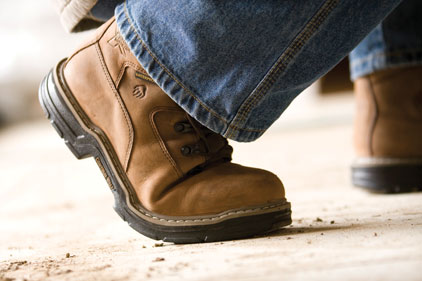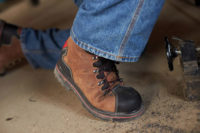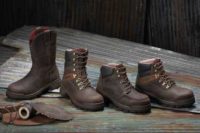1. What are some of the main components that people should consider when selecting safety footwear?
Some factors to consider include:
Does your company have guidelines or requirements for safety footwear? Does the footwear need to meet specific ASTM standards?
Do you need a safety toe? Is a steel toe or composite toe better for your work conditions?
Do you need a metatarsal guard?
What kind of outsole materials and design will offer the best performance for your work surface?
What upper materials and design are most appropriate for your work conditions?
What boot height do you need or prefer?
What construction method (direct attach, Goodyear Welt, opanka, cement or a combination of multiple techniques) will offer you the most comfort and performance?
Do you need waterproofing and insulation?
Have you considered comfort-enhancing technologies?
2. What is the most common misconception that people have about safety footwear?
The most common misconception about work boots is that they’re all basically the same when in fact they are really quite varied. Work boots are typically designed with certain end-uses in mind, so the features and materials are specifically selected to provide the best performance in those environments.
For example, polyurethane wedge outsoles with numerous leading edges provide maximum surface contact and slip resistance, which is ideal in many light industrial warehouse settings with smooth, potentially slippery, concrete floors. However you’ll find a higher than average 90-degree heel on the rubber lug outsole of logging boots for traction and climbing. Different outsoles excel in different work environments; that’s what they’re designed to do so it’s important to choose the right features for your work environment.
Boot manufacturers can recommend appropriate styles based on work environment, safety needs and comfort factors. The better the boot features match the end use, the higher level of environment-specific performance the boot can provide.
3. How can people select boots that will fit properly?
Selecting boots that fit properly is an extremely important factor in lasting comfort. When purchasing and trying on boots, it’s best to shop in the afternoon or early evening. Throughout the day feet can swell. By trying on boots later in the day, it’s more likely you’ll select a size that will always feel comfortable, even when spending all day on your feet. It’s also important to wear the socks that will normally be worn with the boots to ensure proper fit. There are many socks that can enhance the comfort of the boots with cushioning and moisture-wicking properties.
4. How can people select boots that will be comfortable?
Another important factor to consider in selecting your boots is the comfort and performance technologies available, like shoes featuring compression pads to help to reduce impact, return energy and provide all-day-long comfort. OrthoLite® and other removable insoles also provide additional cushioning and odor-controlling properties. It’s also imperative to select the appropriate amount of insulation and waterproofing technology if you’re working in cold or wet environments to ensure feet stay dry and warm.
5. What’s the difference between steel toe and composite toe?
Steel is the time-tested mainstay in toe protection. It is affordable and strong, and there are few materials that can meet or exceed the strength, resilience and elasticity of steel. It remains the safety toe of choice for many people.
However, caps thermo-formed from resins and fiberglass composites are gaining popularity. They meet the ASTM standard F2413-11 for safety toes providing the same level of protection as steel with many notable benefits: they are lighter in weight, they do not conduct heat or cold in extreme temperatures like steel does, and they are non-metallic (allowing for easier passing through metal detectors, etc.). However, composite toes do need to be slightly bigger and thicker than steel toe caps in order to offer the same protection, so they can make boots look bigger and fit differently.
In the end, both toe cap options, along with aluminum alloy toe caps, offer the same level of protection; the prices and benefits are what differentiate them.
6. How should people care for their boots in order to extend their useful life?
On a regular basis, brushing away any surface dirt with a soft brush will help maintain the look of the footwear. If the product is significantly dirty after extended use, most boots can be wiped down with a damp cloth. If the product is wet, open the footwear fully, remove the insole and laces, and then let the footwear dry at room temperature. Do not expose the footwear to direct heat (like a hairdryer) because it can adversely affect the boot materials.
Caring for the upper is dependent on the upper materials. The life of leather boots can be extended by conditioning the leather on a regular basis to keep it supple and moisturized. Conditioning also will enhance the look of the leather and develop a softer, more comfortable upper that will start to mold to the foot over time.
7. How do you know when it’s time for a new pair of work boots?
Boots with exposed toe caps, worn-through outsoles, or tears in the uppers should be replaced to ensure that the safety and comfort of the boot are not compromised. Some boots made with Goodyear Welt construction can alternately be re-soled when needed. Boot makers strive to create long-lasting, durable comfortable boots, adding features such as toe-bumpers to ensure that boots can be used for as long as possible. However, there isn’t a boot out there that will last forever.


